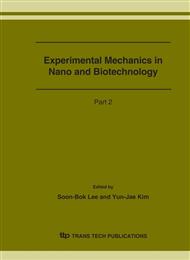p.1205
p.1209
p.1213
p.1217
p.1221
p.1225
p.1229
p.1233
p.1237
Physical Modeling and Characteristics of a Johnsen-Rahbek Type Electrostatic Chuck
Abstract:
Generally, a Johnsen-Rahbek (J-R) type electrostatic chuck (ESC) generates higher attractive force than a Coulomb type ESC. Attractive force in a J-R type ESC is caused by the high electrical resistance that occurs in the contact region between an object plate and a dielectric layer. This research tries the simple geometrical modeling of the contact surface and simulates the contact resistance, the attractive force and the response time according to the variation of contact surface shape. In the latter half of this research, the simulation for a pin-combined chuck is accomplished using a similar surface modeling and the comparison between the pin chuck and the general flat chuck is made in aspects of the attractive force and the response time.
Info:
Periodical:
Pages:
1221-1224
Citation:
Online since:
December 2006
Authors:
Keywords:
Price:
Сopyright:
© 2006 Trans Tech Publications Ltd. All Rights Reserved
Share:
Citation:


